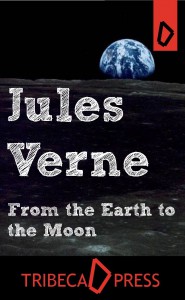
From the Earth to the Moon
 One of the problems with reading Verne is that many terrible English translations of his work exist. FROM THE EARTH TO THE MOON is a particularly difficult book to find, as it contains the two elements of Verne that are frequently changed, misinterpreted, or censored: anti-American satire and detailed scientific speculation. As such, the quality of the translation is probably the first aspect that needs to be covered in a Verne review.
One of the problems with reading Verne is that many terrible English translations of his work exist. FROM THE EARTH TO THE MOON is a particularly difficult book to find, as it contains the two elements of Verne that are frequently changed, misinterpreted, or censored: anti-American satire and detailed scientific speculation. As such, the quality of the translation is probably the first aspect that needs to be covered in a Verne review.The Tribeca Press’ Kindle version does not actually list the translation information anywhere, which should have immediately set off my alarm bells. According to Amazon, the translator of the Tribeca Press is Lowell Bair, but that appears to be incorrect. When comparing the Tribeca edition to known samples of Bair’s 1967 translation of the FROM THE EARTH TO THE MOON, I found that it didn’t resemble his translation at all. In fact, it turned out to be yet another book that uses the Mercier translation. The hopelessly inept public domain Mercier translation. The translation that could be legally obtained for free elsewhere on the ‘net.
Kill me.
As, for the book itself, the Tribeca edition includes both FROM THE EARTH TO THE MOON and its sequel AROUND THE MOON. Both are enjoyable reads worthy of being called classics, though they’re very different stories. The former splits its time evenly between satirizing American behavior (albeit heavily censored by Mercier) and providing grounded speculation of every aspect of how to reach the moon. Such a book has the potential to be weighed down by the scientific analysis, and unfortunately, the Mercier edition of the book fails to overcome this hurdle. The clunky translation of the text makes for silted and dry dialogue, complicated further by the dreamlike veneer that Mercier tries to glue on top of exposition and frequent summarizations thereof.
Nonetheless, it’s amazing how close Verne’s predictions came to reality; not only in the precise calculations and costs of such a journey, but also the zealous patriotic fervor required to support such a venture. FROM THE EARTH TO THE MOON is simply an absolute must-read for fans of classic hard-scifi (and humor).
AROUND THE MOON isn’t nearly as fun as its predecessor, but it’s much more suspenseful. The idea of being trapped in a bullet-shaped prison in the depths of outer space is portrayed as realistically as it could be done in the late 19th century. There are scientific blunders, of course—for example, the group regularly opens up windows and tosses things into space with no consequences—but for the most part, it takes elements like the lack of control of the trio’s vessel, their limited supplies, and hostile environment of space itself and plays them straight. On the downside, a huge portion of the book is spent exploring a plethora of dated theoretical space concepts. Unlike FROM THE EARTH TO THE MOON, where the science is about speculating how then-current gunnery technology could do the impossible, AROUND THE MOON merely explores how then-current theories about the moon might be observed in space. In a post-NASA world, that’s not groundbreaking anymore.
Even so, both halves of FROM THE EARTH TO THE MOON are an absolute treat from beginning to end, dated science aside. If I were reviewing content alone, it would easily deserve a four- or five-star rating. Unfortunately, I can’t recommend this edition: avoid the Tribeca Press’ FROM THE EARTH TO THE MOON at all costs.

















